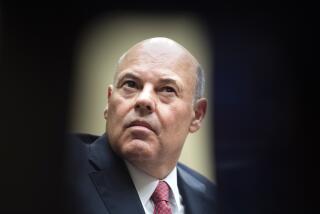Postal Officials Set to Propose 30-Cent Stamp
WASHINGTON — The U.S. Postal Service, facing the biggest one-year deficit in its history, will propose today a nickel increase in the cost of mailing a first-class letter, raising the price to 30 cents.
The proposed hike, if approved by the independent Postal Rate Commission, probably would take effect in January or February of 1991. The rate commission has 10 months to render its decision, although final implementation could take slightly longer.
The cost of mailing a first-class letter has been fixed at 25 cents since April, 1988. The proposed 20% increase would follow what has become a standard pattern of postal rate hikes every three years.
The postal service expects to record a deficit ranging from $1.4 billion to $1.6 billion for the current fiscal year, which ends Sept. 30.
Today’s rate request would cover all categories of mail, with the postal service seeking an overall increase of about 19% in its revenues. The rate commission can accept, modify or potentially reject the postal service proposals for first-class letters, advertising materials, newspapers and magazines, packages and other categories of mail.
The complex and lengthy hearings before the rate commission will become a financial battleground with billions of dollars at stake, as various categories of mailers argue over who should bear the heaviest burdens of the rate increases.
The 5-cent increase, if approved, would be the biggest one-year hike since 1981, when rates rose from 15 cents to 18 cents in March, then jumped to 20 cents the following November. The postal service imposed the 3-cent hike on a temporary basis while awaiting the rate commission’s delayed decision to go to 20 cents.
It would be the biggest percentage increase since the first-class letter rate jumped from 10 cents to 13 cents in 1975, a 30% gain.
The postal service has invested heavily in costly new technology to automate the process of mail sorting and handling, and it has been able to trim its work force by 19,000 persons since last May. The jobs were eliminated through attrition.
The organization has 768,000 workers, and 83% of its budget is consumed by wages and benefits. Labor contracts expire this summer, and postal service management will be pushing the unions hard to accept sharply limited wage increases.
“We are going to ask our employees’ representatives to show some constructive restraint,” Postmaster General Anthony M. Frank told the House Post Office committee last week. “I’m looking for fair, reasonable and realistic bargaining on all sides.”
Frank said that the postal service needs both wage “restraints and the flexibility for managing work hours more effectively.”
The postal service has been independent since 1971.
More to Read
Sign up for Essential California
The most important California stories and recommendations in your inbox every morning.
You may occasionally receive promotional content from the Los Angeles Times.









